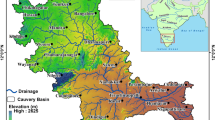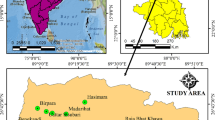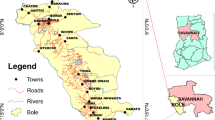Abstract
This study has employed cokriging and weighted overlay techniques in a GIS environment to delineate groundwater potential zones from hydrogeological parameters in the Assin Municipalities, Ghana, where groundwater is the main source of potable water but access to it is less predictable since the aquifers are structurally controlled. Data from drilling logs, borehole development and construction, and pumping test on 67 boreholes in the area were utilized to estimate the hydrogeological parameters such as borehole yield, transmissivity, specific capacity, aquifer thickness and water strike elevation. Then, using the cokriging and weighted overlay techniques in ArcGIS, spatial thematic maps were created for all the parameters and integrated to produce the groundwater potential map, which categorized the study area into very low, low, moderate, and high groundwater potential zones. The results revealed that the cokriging technique was better in delineating the groundwater potential zones of the study area with a prediction accuracy of 67%, while the weighted overlay approach had an accuracy of 44%. However, the delineated moderate and high groundwater potential zones in the area for both approaches were largely the same and underlined by granitic rocks. Also, the generated groundwater potential map categorized approximately 0.1% (2.78 km2), 35.2% (850.45 km2), 43.6% (1054.62 km2) and 21.1% (509.15 km2) of the study area as very low, low, moderate and high groundwater potential zones, respectively. Thus, the study provides very useful information on groundwater potential zones delineation, which would aid in effective exploration and development of groundwater resources.








Similar content being viewed by others
Availability of data and materials
The datasets generated during and/or analysed during the current study are available from the corresponding author on reasonable request.
References
Ahmadi SH, Sedghamiz A (2008) Application and evaluation of Kriging and Cokriging methods on groundwater depth mapping. Environ Monit Assess 138:357–368
Akinlalu AA, Adegbuyiro A, Adiat KAN, Akeredolu BE, Lateef WY (2017) Application of multi-criteria decision analysis in prediction of groundwater resources potential: a case of Oke-Ana, Ilesa Area Southwestern, Nigeria. NRIAG J Astron Geophys 6(1):184–200
Al-Abadi AM, Fryar AE, Rasheed AA, Pradhan B (2021) Assessment of groundwater potential in terms of the availability and quality of the resource: a case study from Iraq. Environ Earth Sci 80(12):1–22
Andualem TG, Demeke GG (2019) Groundwater potential assessment using GIS and remote sensing: a case study of Guna Tana Landscape, Upper Blue Nile Basin Ethiopia. J Hydrol Reg Stud 24:100610
Anteneh Z, Alemu MM, Bawoke GK 1994 etnet, Kehali A, Fenta M, Desta MT (2021) Appraising groundwater potential zones using geospatial and multi-criteria decision analysis (MCDA) techniques in Andasa-Tul Watershed, Upper Blue Nile basin, Ethiopia. https://doi.org/10.21203/rs.3.rs-309494/v1
Armah TK (2000) Groundwater salinization in parts of Southern Ghana. In: Oliver S (ed) Groundwater: past achievements and future challenges, (Proceedings of IAH Congress on Groundwater, 26 November 2000). A.A. Balkema Publication, Rotterdam. Pp 445–449
Arulbalaji P, Padmalal D, Sreelash K (2019) GIS and AHP techniques-based delineation of groundwater potential zones: a case study from Southern Western Ghats India. Sci Rep 9(1):1–17
Asante-Annor A, Acquah J, Ansah E (2018) Hydrogeological and hydrochemical assessment of basin granitoids in Assin and Breman Districts of Ghana. J Geosci Environ Protect 6(9):31–57
Bashe BB (2017) Groundwater potential mapping using remote sensing and gis in Rift Valley Lakes Basin, Weito Sub Basin Ethiopia. Int J Sci Eng Res 8(2):43–50
Buckley DK (1986) Report on advisory visit to water aid projects in Ghana. Unpublished Report, British Geological Survey, Hydrogeology Research Group, Wallingford
Chowdhury A, Jha MK, Chowdary VM, Mal BC (2009) Integrated remote sensing and GIS-based approach for assessing groundwater potential in West Medinipur District, West Bengal India. Int J Remote Sens 30(1):231–250
CWSA (Community Water and Sanitation Agency) (2010) Small Community Sector Guidelines. CWSA Publication, Accra
Deutsch CV, Journel AG (1992) Geostatistical Software Library and User’s Guide. New York, 119(147)
Dickson KB, Benneh G, Essah RR (1988) A new geography of Ghana. Longman Group Ltd., London, p 34
Edet AE, Okereke CS (1997) Assessment of hydrogeological conditions in basement aquifers of the Precambrian Oban Massif, Southeastern Nigeria. J Appl Geophys 36(4):195–204
Eldeiry AA, Garcia LA (2012) Evaluating the performance of ordinary kriging in mapping soil salinity. J Irrig Drain Eng 138(12):1046–1059
ESRI (Environmental Systems Research Institute) (2016). ArcMap. How Kriging works. Retrieved from https://www.desktop.arcgis.com/en/arcmap/1.0.3/tools/3d-analyst-toolbox/how-kriging-works.htm#. Accessed on 09 Jul 2021
Ewusi A, Kuma JS (2011) Calibration of shallow borehole drilling sites using the electrical resistivity imaging technique in the Granitoids of Central Region Ghana. Nat Resour Res 20(1):57–63
FAO (Food and Agriculture Organization of the United Nations). 2002. Project Intégré Keita. Rapport Terminal du Project. Project GCP/NER/032/ITA. Rome, FAO
Ganyaglo SY, Banoeng-Yakubo B, Osae S, Dampare SB, Fianko JR, Bhuiyan MA (2010) Hydrochemical and isotopic characterisation of groundwater in Eastern Region of Ghana. Water Resour Protect 2:199–208
Ganyaglo SY, Osae S, Dampare SB, Fianko JR, Bhuiyan MA, Gibrilla A, Osei J (2012) Preliminary groundwater quality assessment in the central region of Ghana. Environ Earth Sci 66(2):573–587
Gibrilla A, Akiti TT, Osae S, Adomako D, Ganyaglo SY, Bam EPK, Hadisu A (2010) Origin of dissolve ions in groundwaters in the Northern Densu River Basin of Ghana Using stable isotopes of 18O and 2H. J Water Resour Prot 2(12):1010–1019
Gibrilla A, Bam EKP, Adomako D, Ganyaglo S, Osae S, Akiti TT, Kebede S, Achoribo E, Ahialey E, Ayanu G, Agyeman EK (2011) Application of Water Quality Index (WQI) and multivariate analysis for groundwater quality assessment of the Birimian and Cape Coast Granitoid Complex: Densu River Basin of Ghana. Water Qual Expo Health 3(2):63–78
Giraldo R, Herrera L, Leiva V (2020) Cokriging prediction using as secondary variable a functional random field with application in environmental pollution. Mathematics 8(8):1305
Gogu R, Carabin G, Hallet V, Peters V, Dassargues A (2001) GIS-Based hydrogeological databases and groundwater modelling. Hydrogeol J 9(6):555–569
Goodchild MF (1993) The state of GIS for environmental problem-solving. In: Goodchild MF, Parks BO, Steyaert LT (eds) Environmental modeling with GIS. Oxford University Press, New York, pp 8–15
Goovaerts P (1997) Geostatistics for natural resources evaluation. Oxford University Press on Demand
GSA (Geological Survey Authority) (2009) Geological Map of Ghana 1:1000000, GSD, Accra, Ghana
GSD (Geological Survey Department) (2009) Geological Map of Ghana 1:1000000, GSD, Accra, Ghana
GSS (Ghana Statistical Service) (2012) Population and Housing Census. Ghana Statistical Service, Accra, Ghana
Gumma MK, Pavelic P (2013) Mapping of groundwater potential zones across Ghana using remote sensing, geographic information systems, and spatial modeling. Environ Monit Assess 185(4):3561–3579
Hoeksema RJ, Clapp RB, Thomas AL, Hunley AE, Farrow ND, Dearstone KC (1989) Cokriging model for estimation of water table elevation. Water Resour Res 25:429–438
Hooshmand A, Delgh M, Izadi A, Amadali KA (2011) Application of Kriging and Cokriging in spatial estimation of groundwater quality parameters. Afr J Agric Res 6(14):3402–3408
Hu K, Huang Y, Li H, Li B, Chen D, White RE (2005) Spatial variability of shallow groundwater level, electrical conductivity and nitrate concentration, and risk assessment of nitrate contamination in North China Plain. Environ Int 31(6):896–903
Hussein AA, Govindu V, Nigusse AGM (2017) Evaluation of groundwater potential using geospatial techniques. Appl Water Sci 7(5):2447–2461
Israil M, Al-Hadithi M, Singhal DC (2006) Application of a resistivity survey and geographical information system (GIS) analysis for hydrogeological zoning of a piedmont area, Himalayan Foothill Region India. Hydrogeol J 14(5):753–759
Jaiswal RK, Mukherjee S, Krishnamurthy J, Saxena R (2003) Role of remote sensing and GIS techniques for generation of groundwater prospect zones towards rural development—an approach. Int J Remote Sens 24(5):993–1008
Jha MK, Peiffer S (2006) Applications of remote sensing and GIS technologies in groundwater hydrology: past, present and future. BayCEER, Bayreuth
Jhariya DC, Kumar T, Gobinath M, Diwan P, Kishore N (2016) Assessment of groundwater potential zone using remote sensing, GIS and multi criteria decision analysis techniques. J Geol Soc India 88(4):481–492
Kanagaraj G, Suganthi S, Elango L, Magesh NS (2019) Assessment of groundwater potential Zones in Vellore district, Tamil Nadu, India using geospatial techniques. Earth Sci Inf 12(2):211–223
Kortatsi BK (1994) Groundwater utilization in Ghana. IAHS Publications-Series of Proceedings and Reports-Intern Assoc Hydrological Sciences, 222, 149–156
Krásný J (1993) Classification of transmissivity magnitude and variation. Groundwater 31(2):230–236
Krishnamurthy J, Mani A, Jayaraman V, Manivel M (2000) Groundwater resources development in hard rock terrane-an approach using remote sensing and GIS techniques. Int J Appl Earth Observ Geo-Inform 2(3–4):204–215
Kumar S, Machiwal D, Parmar BS (2019) A parsimonious approach to delineating groundwater potential zones using geospatial modeling and multicriteria decision analysis techniques under limited data availability condition. Eng Rep 1(5):2073
Magesh NS, Chandrasekar N, Soundranayagam JP (2012) Delineation of groundwater potential Zones in Theni District, Tamil Nadu, using remote sensing GIS and MIF Techniques. Geosci Front 3(2):189–196
Mallick J, Khan RA, Ahmed M, Alqadhi SD, Alsubih M, Falqi I, Hasan MA (2019) Modeling groundwater potential zone in a Semi-Arid Region of Aseer using fuzzy-AHP and geo-information techniques. Water 11(12):2656
Mohammed-Aslam MA, Kondoh A, Rafeekh PM, Manoharan AN (2010) Evaluating groundwater potential of a hard-rock aquifer using remote sensing and geophysics. J Spat Hydrol 10(1):76–88
Mukherjee P, Singh CK, Mukherjee S (2012) Delineation of groundwater potential zones in Arid Region of India—a remote sensing and GIS approach. Water Resour Manag 26(9):2643–2672
Murthy KSR (2000) Groundwater potential in a semi-arid region of Andhra Pradesh—a geographical information system approach. Int J Remote Sens 21(9):1867–1884
NRC (National Research Council) (1996) Rock fractures and fluid flow: contemporary understanding and applications. National Academies Press, Washington
Nsiah E, Appiah-Adjei EK, Adjei KA (2018) Hydrogeological delineation of groundwater potential zones in the Nabogo Basin, Ghana. J Afr Earth Sc 143:1–9
Oh HJ, Kim YS, Choi JK, Park E, Lee S (2011) GIS mapping of regional probabilistic groundwater potential in the area of Pohang City Korea. J Hydrol 399(3–4):158–172
Pinto D, Shrestha S, Babel MS, Ninsawat S (2017) Delineation of groundwater potential zones in the Comoro Watershed, Timor Leste using GIS, remote sensing and analytic hierarchy process (AHP) technique. Appl Water Sci 7(1):503–519
Prackley S (1984) The 30-well project. Internal Report, Catholic Diocese of Accra, Accra
Preeja KR, Joseph S, Thomas J, Vijith H (2011) Identification of groundwater potential zones of a Tropical River Basin (Kerala, India) using remote sensing and GIS techniques. J Indian Soc Remote Sens 39(1):83–94
Rao NS (2003) Groundwater prospecting and management in an agro-based rural environment of crystalline terrane of India. Environ Geol 43(4):419–431
Sander P, Chesley MM, Minor TB (1996) Groundwater assessment using remote sensing and GIS in a rural groundwater project in Ghana: lessons learned. Hydrogeol J 4(3):40–49
Sener E, Davraz A, Ozcelik M (2005) An integration of GIS and remote sensing in groundwater investigations: a case study in Burdur Turkey. Hydrogeol J 13(5–6):826–834
Shahid S, Nath SK (2002) GIS integration of remote sensing and electrical sounding data for hydrogeological exploration. J Spat Hydrol 2(1)
Shahid S, Nath S, Roy J (2000) Groundwater potential modelling in a soft rock area using a GIS. Int J Remote Sens 21(9):1919–1924
Sikdar PK, Chakraborty S, Adhya E, Paul PK (2004) Land use/land cover changes and groundwater potential zoning in and around Raniganj Coal Mining Area, Bardhaman District, West Bengal—a GIS and remote sensing approach. J Spat Hydrol 4(2):1–24
Sreedevi PD, Subrahmanyam K, Ahmed S (2005) Integrated approach for delineating potential zones to explore for groundwater in the Pageru River Basin, Cuddapah District, Andhra Pradesh India. Hydrogeol J 13(3):534–543
Srinivasa Rao Y, Jugran DK (2003) Delineation of groundwater potential zones and zones of groundwater quality suitable for domestic purposes using remote sensing and GIS. Hydrol Sci J 48(5):821–833
Srivastava PK, Bhattacharya AK (2006) Groundwater assessment through an integrated approach using remote sensing, GIS and resistivity techniques: a case study from a hard rock terrane. Int J Remote Sens 27(20):4599–4620
Stafford DB (1991) Civil engineering applications of remote sensing and geographic information systems. In: A conference, (Proceedings of the Second National Specialty Conference, 14–16 May 1991). American Society of Civil Engineers
Theis CV (1935) The relation between the lowering of the piezometric surface and the rate and duration of discharge of a well using ground-water storage. EOS Trans Am Geophys Union 16(2):519–524
Todd DK (1980) Groundwater hydrology. Wiley, New York
UNESCO (United Nations Educational, Scientific and Cultural Organization) (2012) World’s Groundwater Resources are Suffering from Poor Governance. UNESCO Natural Sciences Sector News. Paris, UNESCO
van Tonder G, Kunstmann H, Xu Y, Fourie F (2000) Estimation of the sustainable yield of a borehole including boundary information, drawdown derivatives and uncertainty propagation. In: Calibration and Reliability in Groundwater Modelling: Coping with Uncertainty, (Proceedings of the ModelCare'99 Conference Held in Zurich, Switzerland, 20–23 September 1999) IAHS Publications 265: 367
Waikar ML, Nilawar AP (2014) Identification of groundwater potential zone using remote sensing and GIS technique. Int J Innov Res Sci Eng Technol 3(5):12163–12174
WRI (World Resources Institute) (1992) World Resources, 1992–1993. Oxford University Press, New York
Xu Y, Usher B (2006) Issues of groundwater pollution in Africa. In: By Y (ed) Groundwater pollution in Africa. Taylor & Francis, London, pp 3–9
Yalcïn E (2005) Cokriging and its effect on the estimation precision. J South Afr Inst Min Metall 105(4):223–228
Yeh HF, Lee CH, Hsu KC, Chang PH (2009) GIS for the assessment of the groundwater recharge potential zone. Environ Geol 58(1):185–195
Yifru BA, Mitiku DB, Tolera MB, Chang SW, Chung IM (2020) Groundwater potential mapping using SWAT and GIS-based multi-criteria decision analysis. KSCE J Civ Eng 24(8):2546–2559
Zare CM, Zare CA, Malekian A, Bagheri R, Vesali SA (2014) Evaluation of different cokriging methods for rainfall estimation in Arid Regions (Central Kavir Basin in Iran). Desert (BIABAN) 19(1):1–9
Acknowledgements
Authors wish to thank Tullow Ghana for supporting this research through a graduate student scholarship. Again, the authors acknowledge Community Water and Sanitation Agency, Central Region, Ghana for making data available for the research.
Funding
No funding was received for conducting this study.
Author information
Authors and Affiliations
Corresponding author
Ethics declarations
Conflict of interest
The authors have no conflicts of interest to declare that are relevant to the content of this article.
Additional information
Publisher's Note
Springer Nature remains neutral with regard to jurisdictional claims in published maps and institutional affiliations.
Rights and permissions
About this article
Cite this article
Asante, D., Appiah-Adjei, E.K. & Asare, A. Delineation of groundwater potential zones using cokriging and weighted overlay techniques in the Assin Municipalities of Ghana. Sustain. Water Resour. Manag. 8, 55 (2022). https://doi.org/10.1007/s40899-022-00639-8
Received:
Accepted:
Published:
DOI: https://doi.org/10.1007/s40899-022-00639-8




